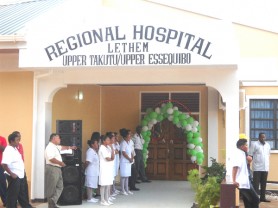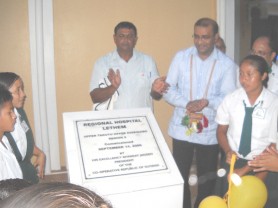Hours after teaming up with Brazilian President Luiz Inacio Lula da Silva to commission the Takutu Bridge, President Bharrat Jagdeo on Monday officially declared open the new regional hospital for Region Nine (Upper Takutu/Upper Essequibo) at Lethem.

Minister within the Health Ministry Dr Bheri Ramsarran noted that the new facility was a joint venture between the Caribbean Development Bank (CDB) and the Government of Guyana.
He said that the CDB had partnered with the government to provide funding for two hinterland hospitals one at Lethem and the other at Mabaruma, both of which have been completed. Both hospitals had opened their doors to citizens although neither had been officially commissioned by the government, the minister noted, even as he stated that recently government has established several health facilities without the accompanying pomp and ceremony.
Speaking specifically about the Lethem hospital, Ramsarran said it was a state-of-the art facility which would rival any regional hospital in the country. He said the hospital would also be adequately staffed with personnel who had the skills that were necessary.

The hospital is also equipped with a reconditioned ambulance, which the minister noted was much more than “a minibus with a stretcher inside”, as was the case with ambulances at some private and public hospitals.
While noting that all was not perfect with the local health sector, Ramsarran said that with investments by the government, the sector was progressing rapidly.
In the feature address, President Jagdeo said the hospital was another initiative by the government to improve the lives of citizens living off the coast. He said historically, the services offered by the state lagged far behind those offered on the coast, but the PPP/C administration has been working ever since it came to power to bridge this gap.
The President said that the issue of development of the interior communities was a priority since persons should have the freedom to choose where they live, and having made their choice should have opportunities to prosper. He noted that key to bridging the gap in development was ensuring that persons have opportunities for education and healthcare. He explained that this is why the government is spending so much in the health and education sectors.
However, Jagdeo noted that there were still “more needs than resources” and the government had to limit its spending, since it could not afford to live above its means. He pointed out that when the country did so in its past the consequences were dire for the nation. “We still have more needs than resources,” he said.
Speaking about the developments in the health sector, Jagdeo said that there has been some noticeable improvement in the sector especially with regard to training of more doctors. According to him, a few years ago there were only about 150 doctors in the local health system but in another five years there will be about 750 doctors will be added to this number.
Meanwhile, Jagdeo once again underscored the importance of developing agriculture in the hinterland regions, while emphasizing that this needed to be done in a sensible manner that would lead to economic development without hindering the environment. He also said that each of the villages needed to find a sustainable activity which would help create jobs for its people.




